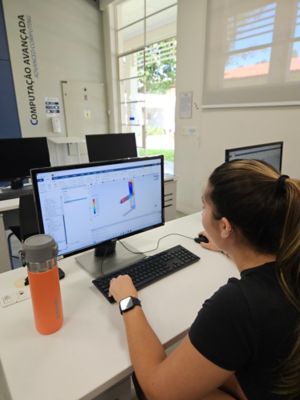The Ansys 2023 R2 release of Ansys Rocky pushes particle simulation beyond traditional discrete element modeling (DEM) with cutting-edge smoothed-particle hydrodynamics (SPH) post-processing and expanded multiphysics coupling capabilities.
Additionally, it offers massive performance enhancements and usability improvements, making it the ultimate engineering simulation tool.
Let's look at some of the new features.
Advanced SPH Post-Processing
Unlock new insights into fluid simulation with state-of-the-art SPH post-processing capabilities.
- SPH element tagging: Enables detailed analysis of fluid dynamics in critical areas of interest by tagging and tracking fluid elements, precisely following specific portions of the fluid throughout the simulation.
- Streamlines visualization: Provide invaluable insights into flow behavior by visualizing and tracking fluid trajectories to uncover flow patterns, identify critical areas, and optimize designs.

Streamlines are used to identify the water splashing pattern (left) while the cumulative wet time is useful to assess the water exposure in a car wading simulation (right).
- Fluid-boundary interaction analyses: Evaluate wetting behavior using wet time and wet fraction statistics. Gain crucial understanding of fluid-boundary interactions with the calculation of normal and shear stresses. Explore convective heat transfer dynamics with the calculation of fluid-boundary heat transfer rate.
Big Geometries Handling
Improved graphics processing unit (GPU) algorithms empower you to effortlessly handle massive STL files and take on much larger geometries with the Rocky solver.
- Advanced algorithms for rendering and 3D manipulation: Ensure smooth importation and visualization of large STLs.
- Optimized simulation algorithms: Run detailed geometries faster without compromising the simulation accuracy.
- Efficient memory management: Maximize computational resources to enable the simulation of huge cases.
Expanded Multiphysics Coupling
Unleash the full potential of multiphysics coupling and solve complex problems like never before. Furthermore, there are new modules ready-to-use seamlessly integrate multiple physics for comprehensive simulation and analysis.
- SPH air drag module: This beta feature accounts for the interaction with a constant airflow when solving the liquid phase using the SPH solver.
- Non-drag forces in unresolved coupling: Extended the torque and lift laws functionality for Ansys Fluent two-way coupling.
- Magnetic alignment: Added orientation support in the magnetic force module.
Semi-Resolved Coupling
This release brings several semi-resolved setup and convergence criteria improvements:
- Amplify user control by exposing method parameters in the user interface (UI).
- Improve accuracy by incorporating method residuals for computational fluid dynamics (CFD) convergence control.
- Enhance semi-resolved coupling with shells.

Fluid flows
through a packed bed of particles (left) simulated using the
semi-resolved coupling, showing the fluid velocity contours (right).
Flexible Fibers Modeling
Model single, multi-element fibers with different joint properties, including joint elasticity, plasticity, and breakage, using the new heterogeneous custom fiber module.
User Interface and Usability Improvements
Several improvements were made to increase the multiphysics capabilities among Rocky and Ansys tools integration:
- Standardization of orientation and rotation: All entities use the same method for positioning and orientation.
- Particle mass flow in and out curves: Easy extract of mass flow rates.
- User (script) generated curves and properties saved in project: Avoid the need to recompute properties when reopening the case.
- Save Rocky archive without results: No need to delete results before archiving and sharing the project.

Particle Mass Flow In/Out curves enable easy monitoring of cyclone performance per particle size.
Learn more about how Ansys Rocky can help your DEM needs.









No comments:
Post a Comment